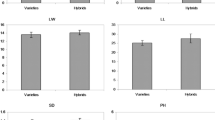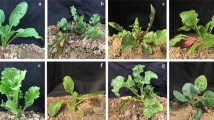Abstract
To develop a new type of orchid with low-temperature tolerance and good fragrance, we generated intergeneric crosses between Korea-native wind orchids and tropical Phalaenopsis. In 2009, 160 cross combinations were made among Sedirea japonica, Phalaenopsis, Doritaenopsis and Neofinetia falcata. High incompatibility was observed from most of crosses as evidenced by traits such as early dropping of seed pods after pod formation or no seed formation after pod maturation. A total of 528 hybrid seedlings were obtained from 12 cross combinations. From these hybrid plants, several lines were selected based on flower type, inflorescence, cold tolerance, and fragrance, and finally the three best lines were selected. The selected lines were generally intermediate in both phenotype and genetic characters of the two parents, but tended to be more similar to Phalaenopsis.
Similar content being viewed by others
Literature Cited
Arditti, J. 1992. Fundamentals of orchid biology. John Wiley & Sons. New York, NY, USA p. 573–574.
Arditti, J. 1977. Orchid biology, reviews and perspectives, I, Cornell University Press, Ithaca, NY, USA p. 55–68.
Been, C.G. 2010. Breeding of fragrant yellow Phalaenopsis and scent pattern analysis by GC/SAW electronic nose system. Kor. J. Hort. Sci. Technol. 28:656–663.
Freed, H. 1980. An update on breeding with the boreneo-type Phalaenopsis violecea. Amer. Orchid Soc. Bull. 49:843–849.
Frowine, S.A. 2008. Moth orchids. Timber press. Portland, London.
Hur, M.S. 2006. Genetic analysis for the backcross breeding in Sedirea japonica. Master thesis, Konkuk University, Seoul, Korea.
Kim, Y.J. and J.S. Lee. 1979. Exploitation of native orchid plants and their propagation for the floricultural crops (1). Wild orchid survey and propagation. J. Kor. Soc. Hort. Sci. 20:94–105.
Lee, N.S. 2011. Illustrated flora of Korean orchids. Ewha Women University Press, Seoul, Korea.
Rajkumar, K. and J.S. Gurumayum. 2009. Intergeneric hybrid of two rare and endangered orchids, Renanthera imschootiana Rolfe and Vanda coerulea Griff. Ex L. (Orchidaceae): Synthesis and characterization. Euphytica 165:247–256.
Rentoul, J.N. 1991. The hybrid story. Lothian Books, Melbourne p. 16.
Stort, M.N.S. 1984. Sterility barriers of some artificial F1 orchid hybrids: Male sterility. 1. Microsporogenesis and pollen germination. Amer. J. Bot. 71:309–318.
Stort, M.N.S. and M.A.M. Morales. 1987. Sterility barriers in some artificial F1 orchid hybrids. Female sterility. Revista Brasileira de Genetica 109.
Author information
Authors and Affiliations
Corresponding author
Rights and permissions
About this article
Cite this article
Kim, D.G., Kim, K.K. & Been, C.G. Development of intergeneric hybrids between wind orchids (Sedirea japonica and Neofinetia falcata) and moth orchids (Phalaenopsis alliances). Hortic. Environ. Biotechnol. 56, 67–78 (2015). https://doi.org/10.1007/s13580-015-0120-3
Received:
Revised:
Accepted:
Published:
Issue Date:
DOI: https://doi.org/10.1007/s13580-015-0120-3




